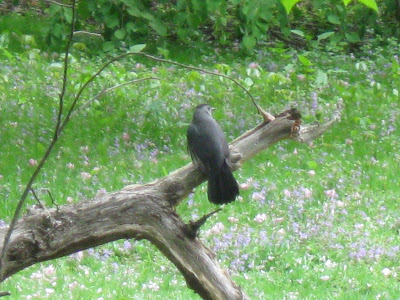 |
| An Eastern Kingbird perches atop temporary fencing around the Newton City Hall park dredging project. Image copyright Daniel E. Levenson 2013. |
New England weather is a funny thing, unpredictable and capricious. Take today for example, the morning started off brisk but sunny and then slowly a few white puffy clouds rolled in, later joined by a few more. Then some gray clouds appeared, there was an occasional drop of rain and I found myself birding around Newton, MA wearing a fleece jacket. In any case, the weather may have taken a temporary step back in time, but the birds still seem to be here and many were quite active this afternoon.
 |
| For the past few months the city of Newton, Massachusetts has been dredging a stream/pond/marshy area near the city hall. Image copyright Daniel E. Levenson 2013. |
My first stop was at Newton city hall where a dredging project has been going on in the stream/pond area in the park along Walnut Street for the past few months. I have been checking this spot carefully as the dredging has been going on, to see which species returned to the park and which seemed to be absent. Now that spring migration is well underway I was not too surprised to see that the birds which were not too dependent on the marsh and mud flats were back, while those which did, appeared to be absent -the advantage has seemingly shifted to the birds that were mainly making use of the surrounding trees, brush and other vegetation. I should note that with the park still officially closed I could only view the birds that could be seen from the perimeter, but still, I think I got a fairly good sense of how the change to this small piece of habitat is affecting the birds.
 |
| Over the last week Gray Catbirds, such as the one in the photo above, have arrived throughout eastern Massachusetts. Image copyright Daniel E. Levenson 2013. |
Some of the birds which do not seem to have been impacted adversely include Eastern Kingbird, Mourning Dove, Chimney Swift, gray Catbird, Song Sparrow and Northern Flicker, all of which I saw today on my visit. While Eastern Kingbirds do like to be near the water to hunt insects, I don't believe they would have relied on the presence of aquatic vegetation and mud flats as a key element in assuring the presence of food. Noticeably absent was any sign of nesting Wood Ducks, which I have noted for the last few springs, as well as Great Blue Heron, Solitary Sandpiper and Spotted Sandpiper. It's possible some of these birds are not back yet, or if they are they have moved on to other places. Either way, their absence was noteworthy. Red-winged blackbirds have been present this year, but not in the numbers I've seen in past years and I did not notice any signs when I was there today that they were nesting near the water. I plan to go back again soon to see how these changes will impact wildlife in the park and once the fencing is removed I will do a more thorough update as well.
I finished off the afternoon with a quick visit to Nahanton Park, hoping to see the Northern Water Thrush that eluded me during Sunday's bird walk with the Friends of Nahanton Park and the Newton Conservators. The wood thrush did not cooperate, but I did see Yellow and Black-and-White Warblers, the ubiquitous Tree Swallows, a few noisy Baltimore Orioles and a Turkey Vulture which came flying in low over the soccer field.
 |
| A Turkey Vulture flies low over Nahanton Park in Newton, Massachusetts. Image copyright Daniel E. Levenson 2013. |
Wandering around Nahanton Park I spent some time thinking about not only the importance of wild, unbroken, un-fractured landscapes, but about the vital role that city parks and green spaces play in the lives of migratory and resident wildlife. The park at Newton City Hall is not very big, but in this small area I have seen close to 70 species of birds over the years, as well as bats, Muskrat, Eastern Cottontail Rabbits and other animals which don't seem to mind that their pond or forest is surrounded by main roads. These places are also immensely valuable for people as well, providing a place to step out of the chaos of our daily lives to rejuvenate and reconnect with the natural world. They are places which we should not take for granted, and for which, I for one, am deeply grateful to have in the city I call home.
Thanks for reading.
Copyright Daniel E. Levenson 2013.




I love the photo of the gray catbird!
ReplyDelete